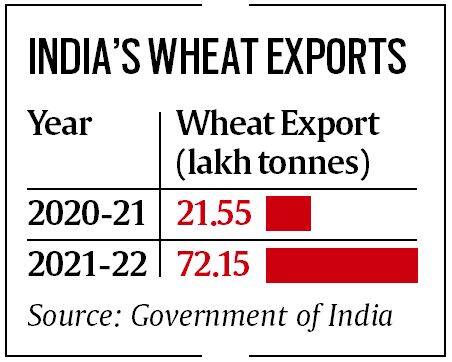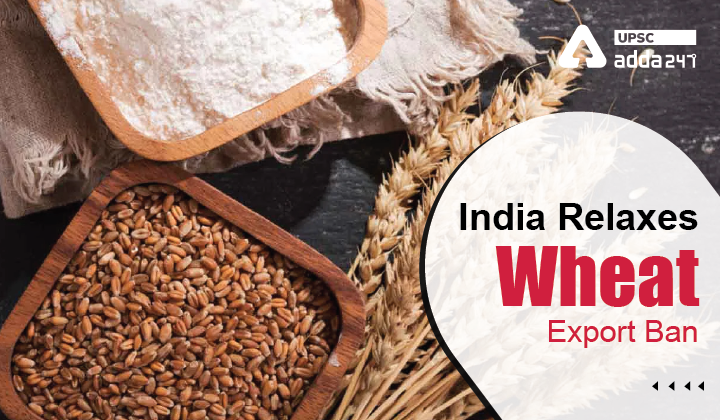Table of Contents
Wheat export ban UPSC: Relevance
- GS 3: Indian Economy and issues relating to planning, mobilization, of resources, growth, development and employment.
Wheat export news: Context
- Recently, the Ministry of Commerce and Industry has announced some relaxations for traders saying that the consignments handed over and registered with Customs on or prior to May 13 — the day India banned the export — shall be allowed to be exported.
Wheat export ban India: Key points
- The government’s move came after a day when it was reported that over 4,000 wheat-laden trucks were stuck in a queue outside Kandla port and four ships were also stranded at the port.
- A quantity of more than 1.6 lakh tonnes was to be loaded on these ships but as soon the ban came into force, the loading was stopped.
- Till then, only around 80 thousand tonnes of wheat could be loaded on these ships.
- These ships were to carry wheat to Brazil, Bangladesh, Oman and Indonesia.
- Egyptian government asked the Indian Counterpart to permit the wheat cargo being loaded at the Kandla port, after which India allowed a wheat shipment headed for Egypt, which was already under loading at the Kandla port.
- Egypt has agreed to buy 5 lakh tonnes of wheat from India.
Wheat export from India: Why India banned wheat exports?
- Russia-Ukraine war: Due to the war, the demand for Indian wheat has increased overseas. In the current financial year 2022-2023, the government estimates about 45 lakh metric tonnes of wheat to have been contracted for exports. Of this, 14.63 lakh metric tonnes have been exported till April 2022, higher than 2.43 lakh metric tonnes exported in April 2021.
- Lower production: Due to heatwave, wheat production in India is expected to be lower than the earlier estimates. In February this year, the government estimated wheat production to reach 111 million tonnes, which was revised to 105-106 million tonnes.
- Lower procurement: Due to a lower production and a higher demand from the private buyers, the government’s procurement of wheat for the PDS is also expected to be much lower this year.
- Inflation: The ban was directed to control the price rise. Retail inflation has been ruling over 6 per cent for four straight months in calendar year 2022, higher than the upper band of RBI inflation target of 6 per cent.

Objective of wheat export ban
According to the commerce ministry, the ban serves three purposes:
- Maintaining the country’s food security,
- Helping those in distress, i.e., if countries make a specific request, the Indian government will take a call,
- India’s reliability as a supplier is being maintained by not reneging on any existing contract.
Impact of ban on wheat export from India
- Rise in international price of wheat: India’s decision to ban wheat exports has fuelled international prices by almost 6 per cent a bushel (60 pounds or one million kernels or 27.21 kg).
- Low-income countries: Research analysts said the impact of India’s export ban would be felt disproportionately by low income developing countries.
- Decline in local prices: Locally, prices dropped sharply by 4-8 per cent in different states — Rs 200-250 a quintal in Rajasthan, Rs 100-150 a quintal in Punjab, and about Rs 100 a quintal in Uttar Pradesh.
- Dents India’s image: Many Asian countries is likely to feel the burnt, with Bangladesh taking the maximum share as it is the biggest buyer of India’s wheat. Moreover, the G-7 countries have also raised objections on the ban.
- Impact on food inflation: The export ban is a pre-emptive step and may prevent local wheat prices from rising substantially; however, with domestic wheat production likely limited by the heatwave, local wheat prices may not moderate materially. If India’s wheat ban leads to higher price of substitutes like rice, then there could be upward pressure on other food prices.
Read current affairs for UPSC





 TSPSC Group 1 Question Paper 2024, Downl...
TSPSC Group 1 Question Paper 2024, Downl...
 TSPSC Group 1 Answer key 2024 Out, Downl...
TSPSC Group 1 Answer key 2024 Out, Downl...
 UPSC Prelims 2024 Question Paper, Downlo...
UPSC Prelims 2024 Question Paper, Downlo...





